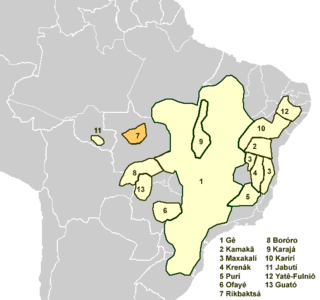Rikbaktsa language
| Rikbaktsá | |
|---|---|
| erigpaksá | |
| Native to | Brazil |
| Region | Mato Grosso |
| Ethnicity | 1,140 Rikbaktsa people (2006)[1] |
Native speakers | 40 (2010)[1] |
Macro-Gê
| |
| Language codes | |
| ISO 639-3 | rkb |
| Glottolog | rikb1245 |
| ELP | Rikbaktsá |
 | |
The Rikbaktsa language, also spelled Aripaktsa, Erikbatsa, Erikpatsa and known ambiguously as Canoeiro, is a language spoken by the Rikbaktsa people of Mato Grosso, Brazil, that forms its own branch of the Macro-Gê languages.
As in other languages of the area, word endings indicate the gender of the speaker.[2] Rikbaktsa is a subject-object-verb language.[1]
Most Rikbaktsa can speak both Rikbaktsa and Portuguese. Younger individuals tend to speak Portuguese more frequently and fluently than their elders, but older individuals generally struggle with Portuguese and use it only with non-indigenous Brazilians.[2]
Jolkesky (2016) also notes that there are lexical similarities with the Cariban languages.[3]
Locations
The 22nd edition of Ethnologue reports that it is spoken around confluence of the Sangue River and Juruena River in:
- Japuira on the east bank of the Juruena River, between the Arinos River and Sangue River
- Posto Escondido on the west bank of the Juruena River (9 villages, 14 settlements)
Phonology
| Front | Central | Back | |
|---|---|---|---|
| Close | i | ɨ | u |
| Close-mid | e | o | |
| Mid | ə | ||
| Open | a |
All vowels have nasalized forms.[4]
| Bilabial | Alveolar | Palato-alveolar | Retroflex | Palatal | Velar | Glottal | ||
|---|---|---|---|---|---|---|---|---|
| Stop | voiceless | p | t | k | ||||
| voiced | b | d | ||||||
| Affricate | t͡ʃ | |||||||
| Fricative | ʃ | h | ||||||
| Nasal | m | n | ||||||
| Approximant | j | w | ||||||
| Flap | ɾ | ɽ | ||||||
Vocabulary
Loukotka (1968) lists the following basic vocabulary items.[5]
gloss Erikbaktsa one aistuːba ear ka-spi tooth írata hand ka-shuisha woman matutsi water pihʔik fire idoː stone harahairi maize uanátsi
References
- ^ a b c Rikbaktsá at Ethnologue (18th ed., 2015) (subscription required)
- ^ a b Arruda, Rinaldo S.V. "Rikbaktsa: Language." In Encyclopedia of Indigenous Peoples in Brazil. Instituto Socioambiental (November 1998).
- ^ Jolkesky, Marcelo Pinho de Valhery (2016). Estudo arqueo-ecolinguístico das terras tropicais sul-americanas (Ph.D. dissertation) (2 ed.). Brasília: University of Brasília.
- ^ "SAPhon – South American Phonological Inventories". linguistics.berkeley.edu. Retrieved 2018-08-12.
- ^ Loukotka, Čestmír (1968). Classification of South American Indian languages. Los Angeles: UCLA Latin American Center.
